Intel reveals 'Ice Lake' codename for upcoming 10nm+ processor family
Intel has yet to even launch its first 10nm chips, dubbed Cannon Lake, but the company has already revealed at least a codename for what is coming after.

Intel has offered an extra-early, if basic, look at one of its upcoming generations of Core processors architectures. As spotted on Intel's codename decoder by Anandtech, Intel has revealed "Ice Lake" as the codename for an upcoming generation of Core processors to be built on the 10 nm+ architecture.
Intel describes the Ice Lake family as a "successor to the 8th generation Intel Core" family. From Intel:
The Ice Lake processor family is a successor to the 8th generation Intel® Core™ processor family. These processors utilize Intel's industry-leading 10 nm+ process technology.
Due to changes to its historical standard "tick-tock" release schedule in recent years, Intel's nomenclature requires a bit of explanation. The "+" on Ice Lake's 10nm+ naming scheme simply designates it as the first refinement to the 10 nm architecture. Using current chips as an example, the company's 7th-generation Kaby Lake chips are built on the same 14nm process as its predecessor Skylake family. Thus, Kaby Lake is currently designated as 14nm+. Another 14nm chip family, dubbed Coffee Lake, is expected later this year and will carry the 14nm++ designation.
It's a bit of a confusing mess, but the ultimate result is that Intel's processors will continue to become more efficient and refined over time.
Alas, we could have quite the wait before we see any Ice Lake chips hit the scene. Cannon Lake, the first chip family built on the 10nm process, has yet to even be fully detailed. Its release is expected sometime in 2018, and Ice Lake will presumably follow not long after. As Anandtech points out, however, it's worth noting that Intel's first 10nm chips were originally projected to debut in 2016, but delays have resulted in multiple refinements and new releases based on the 14nm process.
All the latest news, reviews, and guides for Windows and Xbox diehards.

Dan Thorp-Lancaster is the former Editor-in-Chief of Windows Central. He began working with Windows Central, Android Central, and iMore as a news writer in 2014 and is obsessed with tech of all sorts. You can follow Dan on Twitter @DthorpL and Instagram @heyitsdtl.
